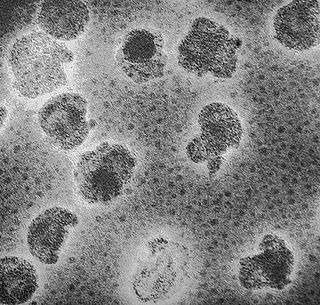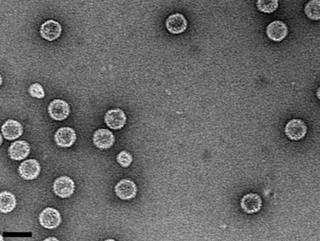
Rubella virus (RuV) is the pathogenic agent of the disease rubella, transmitted only between humans via the respiratory route, and is the main cause of congenital rubella syndrome when infection occurs during the first weeks of pregnancy.

The genus Marburgvirus is the taxonomic home of Marburg marburgvirus, whose members are the two known marburgviruses, Marburg virus (MARV) and Ravn virus (RAVV). Both viruses cause Marburg virus disease in humans and nonhuman primates, a form of viral hemorrhagic fever. Both are Select agents, World Health Organization Risk Group 4 Pathogens, National Institutes of Health/National Institute of Allergy and Infectious Diseases Category A Priority Pathogens, Centers for Disease Control and Prevention Category A Bioterrorism Agents, and are listed as Biological Agents for Export Control by the Australia Group.

Bunyavirales is an order of segmented negative-strand RNA viruses with mainly tripartite genomes. Member viruses infect arthropods, plants, protozoans, and vertebrates. It is the only order in the class Ellioviricetes. The name Bunyavirales derives from Bunyamwera, where the original type species Bunyamwera orthobunyavirus was first discovered. Ellioviricetes is named in honor of late virologist Richard M. Elliott for his early work on bunyaviruses.

Nodaviridae is a family of nonenveloped positive-strand RNA viruses. Vertebrates and invertebrates serve as natural hosts. Diseases associated with this family include: viral encephalopathy and retinopathy in fish. There are nine species in the family, assigned to two genera.

The International Committee on Taxonomy of Viruses (ICTV) authorizes and organizes the taxonomic classification of and the nomenclatures for viruses. The ICTV has developed a universal taxonomic scheme for viruses, and thus has the means to appropriately describe, name, and classify every virus that affects living organisms. The members of the International Committee on Taxonomy of Viruses are considered expert virologists. The ICTV was formed from and is governed by the Virology Division of the International Union of Microbiological Societies. Detailed work, such as delimiting the boundaries of species within a family, typically is performed by study groups of experts in the families.

Orthobunyavirus is a genus of the Peribunyaviridae family in the order Bunyavirales. There are currently ~170 viruses recognised in this genus. These have been assembled into 103 species and 20 serogroups.

Plasmaviridae is a family of bacteria-infecting viruses. Acholeplasma species serve as natural hosts. There is one genus in the family, Plasmavirus, which contains one species: Acholeplasma virus L2. All viruses known in this family have been isolated from species in the class Mollicutes.
Bunyamwera orthobunyavirus (BUNV) is a negative-sense, single-stranded enveloped RNA virus. It is assigned to the Orthobunyavirus genus, in the Bunyavirales order.

The Herpesvirales is an order of dsDNA viruses with animal hosts, characterised by a common morphology consisting of an icosahedral capsid enclosed in a glycoprotein-containing lipid envelope. Common infections in humans caused by members of this order include cold sores, genital herpes, chickenpox, shingles, and glandular fever. Herpesvirales is the sole order in the class Herviviricetes, which is the sole class in the phylum Peploviricota.

Picobirnavirus is a genus of double-stranded RNA viruses. It is the only genus in the family Picobirnaviridae. Although amniotes, especially mammals, were thought to serve as hosts, it has been recently suggested that these viruses might infect bacteria and possibly some other invertebrates. There are three species in this genus. Associated symptoms include gastroenteritis in animals and humans, though the disease association is unclear.
The species Bundibugyo ebolavirus is the taxonomic home of one virus, Bundibugyo virus (BDBV), that forms filamentous virions and is closely related to the infamous Ebola virus (EBOV). The virus causes severe disease in humans in the form of viral hemorrhagic fever and is a Select agent, World Health Organization Risk Group 4 Pathogen, National Institutes of Health/National Institute of Allergy and Infectious Diseases Category A Priority Pathogen, Centers for Disease Control and Prevention Category A Bioterrorism Agent, and is listed as a Biological Agent for Export Control by the Australia Group.
The species Sudan ebolavirus is a virological taxon included in the genus Ebolavirus, family Filoviridae, order Mononegavirales. The species has a single virus member, Sudan virus (SUDV). The members of the species are called Sudan ebolaviruses. It was discovered in 1977 and causes Ebola clinically indistinguishable from the ebola Zaire strain, but is less transmissible than it. Unlike with ebola Zaire there is no vaccine available.

Ampullaviridae is a family of viruses that infect archaea of the genus Acidianus. Only one genus in this family has been described, Bottigliavirus, which contains three species. The name of the family and genus is derived from the Latin word for bottle, ampulla, due to the virions having the shape of a bottle. The family was first described during an investigation of the microbial flora of hot springs in Italy.
Anhembi orthobunyavirus, also called Anhembi virus (AMBV), is a species of virus. It was initially considered a strain of Wyeomyia virus, belonging serologically to the Bunyamwera serogroup of bunyaviruses. In 2018 it was made its own species. It was isolated from the rodent - Proechimys iheringi - and a mosquito - Phoniomyia pilicauda - in São Paulo, Brazil.

Protoparvovirus is a genus of viruses in the Parvovirinae subfamily of the virus family Parvoviridae. Vertebrates serve as natural hosts. There are 15 species in the genus including Rodent protoparvovirus 1 for which the exemplar virus is minute virus of mice (MVM). This genus also includes canine parvovirus (CPV), which causes gastrointestinal tract damage in puppies that is about 80% fatal, and porcine parvovirus (PPV), which is a major cause of fetal death and infertility in pigs. The genus divides phylogenetically into two branches, one that contains many founder members of the family, such as MVM, CPV and PPV, which have been studied in considerable detail, and a second branch occupied exclusively by predicted viruses whose coding sequences were identified recently in the wild using virus discovery approaches, but whose biology remains minimally explored. This second branch currently contains two species whose members infect humans, called Primate protoparvovirus 1 and Primate protoparvovirus 3. Until 2014, the genus was called Parvovirus, but it was renamed to eliminate confusion between members of this genus and members of the entire family Parvoviridae.

Quadriviridae is a family of double-stranded RNA viruses with a single genus Quadrivirus. The fungi Rosellinia necatrix serves as a natural host. The name of the group derives from the quadripartite genome of its members where in Latin quad means four. There is only one species in this family: Rosellinia necatrix quadrivirus 1.

Hantaviridae is a family of viruses in the order Bunyavirales. It is named for the Hantan River area in South Korea where an early outbreak of one of its species was observed.
Bunyamwera is a town in Bundibugyo District, Uganda. It lies just outside of Rwenzori Mountains National Park, which is to the south. The town is north of Kagugu, southeast of Bunyana, and southwest of Butama. Other nearby settlements include Bundimbuga, 1½ km north, and Bundikahondo, 2 km northwest. The peak of Busunga is 6 km northwest, Kyabwageya's peak is 10 km east, and Kinera's peak is 10 km east. The nearest hospital, Kasulenge Health Center II, is 9 km northeast.

Redondoviruses are a family of human-associated DNA viruses. Their name derives from the inferred circular structure of the viral genome . Redondoviruses have been identified in DNA sequence based surveys of samples from humans, primarily samples from the oral cavity and upper airway.
Ngari virus (NRIV) is a single-stranded, negative sense, tri-segmented RNA virus. It is a subtype of the Bunyamwera virus (BUNV) and closely related to the Batai virus (BATV). NRIV is the only reassortment virus of the subtypes. There is evidence suggesting that NRIV stems from a naturally occurring reassortment event in which a host was infected with both BUNV and BATV. It is commonly found in areas that experience an outbreak of Rift Valley fever virus (RFVF)















